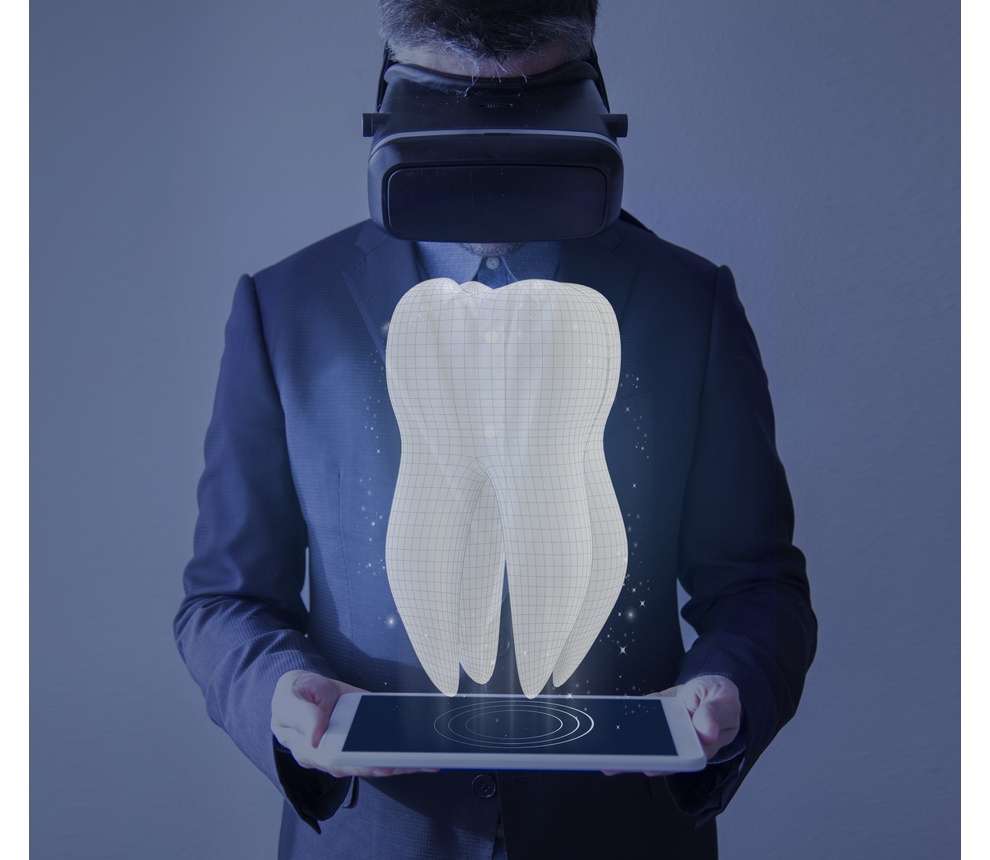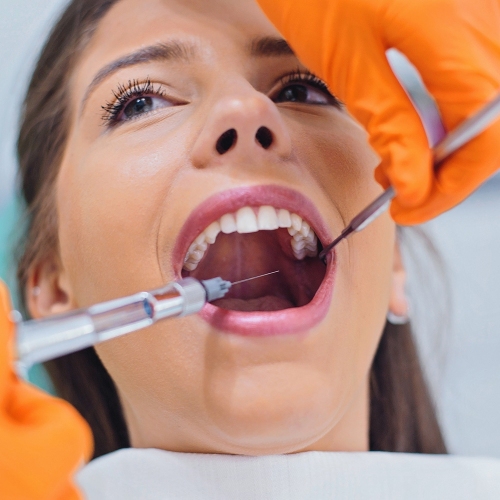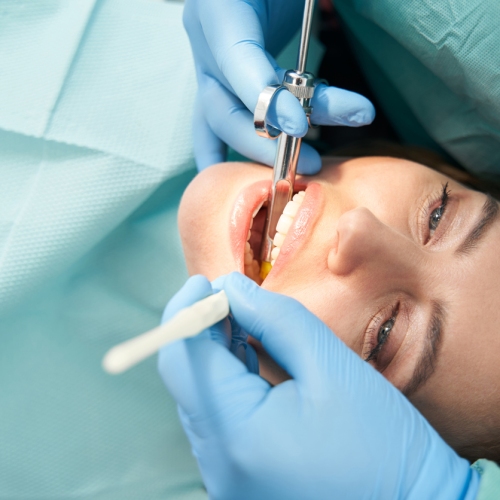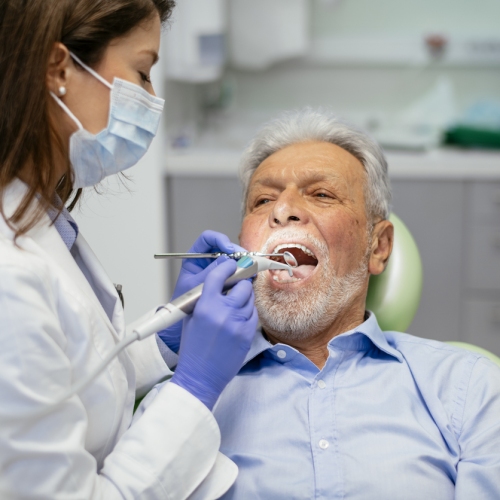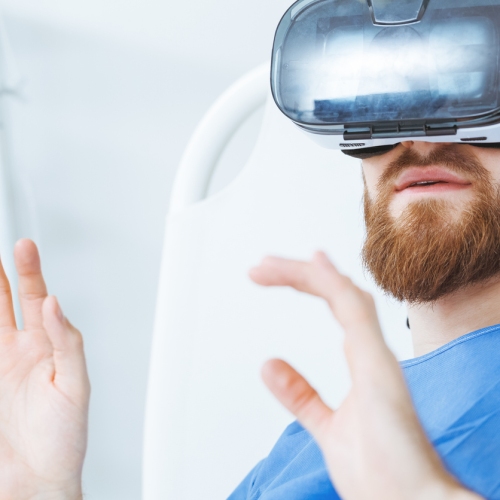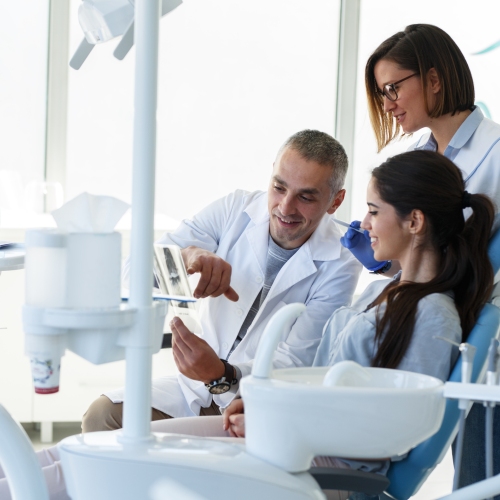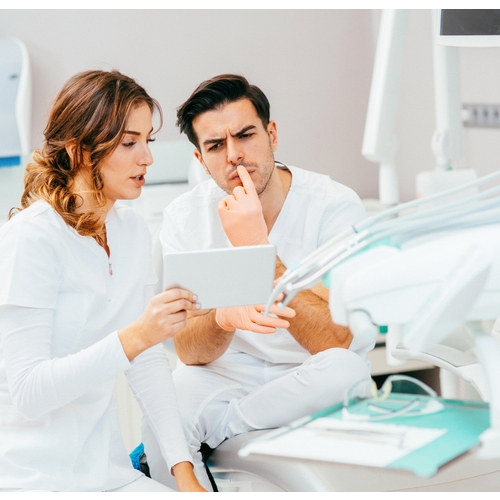Emerging Technologies
Advancements in technology can tackle existing challenges and create opportunities to address emerging challenges. Here are a few of the emerging technologies that have the potential to change dental practice in ways that were once unimaginable.
3-D printing
Three-dimensional (3-D) printing has a wide range of uses in numerous industries, including a variety of medical fields such as dentistry. 3-D printing allows for the rapid fabrication of unique and bespoke devices in an ever-expanding range of materials. In-office computer-aided design and manufacturing (CAD/CAM) has already been used to machine ceramic crowns.1 3-D printing takes this a step further by creating the ability to produce same-day custom dental appliances. Dentures, implants, and orthodontic devices can be produced quickly using 3-D printing. This allows the rapid production of precise, custom-fitted dental appliances on location at a lower cost than traditional methods. 3-D bioprinting using biological materials is an emerging technology that takes 3-D printing to a new level.2

Artificial Intelligence
Artificial intelligence (AI) is a fascinating advancement in technology that is increasingly being used in new ways. AI can be used as a tool to analyze vast amounts of data rapidly. This is allowing various medical and scientific fields to use huge data sets to find patterns and connections that can guide treatment based on complex analyses of outcomes. From generating customized treatment plans to identifying diseases from imaging studies, AI is expected to improve the quality of dental care as it expands into dental practice.3,4
Augmented Reality (AR) and Virtual Reality (VR)
Augmented reality (real-world images overlaid with virtual images) and virtual reality (immersive, fully virtual images) are making their way into dental training and practice.1,5,6 Both AR and VR are being integrated into dental and medical training — especially surgical training — to allow dental students, residents, and practicing dentists to hone their skills.5-7 Combined with imaging technologies, AR can allow dentists to see hidden structures as well as help guide the proper placement of dental instruments. Likewise, VR can allow dentists to plan surgical approaches and interact with three-dimensional images.7

Intra-oral cameras
Dentistry is a very visually-driven branch of medicine that does not rely as heavily on laboratory tests and imaging studies as fields such as internal medicine. Intra-oral camera technology allows dentists to see inside the mouth more easily and with greater visibility.1 This can also be used as part of teledentistry. Not only does this technology help the dentist, but it helps the patient as well. By visualizing the oral cavity on a computer screen, dentists can show patients what is happening inside their mouths. This has the potential to improve patient engagement in their dental care. While the use of intra-oral digital photography is not new, advancements in digital imaging technology are making it more practical than ever.
Regenerative dentistry
Regenerative dentistry is the use of biological materials to repair teeth; more specifically, allowing teeth to grow new healthy tissue such as dentin.8 Using biomaterials, biological or artificial scaffolds, stem cells, and genetic techniques, regenerative technology allows patients to essentially regrow healthy tooth tissue and possibly self-healing teeth.8,9
Smart toothbrushes
Smart technologies are working their way into many appliances in the home, including toothbrushes. Smart toothbrushes can monitor brushing habits, provide feedback, and even make brushing more enjoyable for children through interactive games.1 Bluetooth technology allows smart devices to communicate with apps on smartphones. This can link various sensors incorporated into a smart toothbrush with software that can track and analyze brushing behavior. This can also use artificial intelligence to analyze collected data.

Teledentistry
COVID-19 has driven many industries to increase the use of remote video technologies. Advances in telehealth are allowing patients and providers to interact in ways that were previously unheard of.1 Teleconsultation is allowing dentists and oral surgeons to communicate with one another and share patient data, imaging studies, and live or recorded intra-oral pictures and video.10 Teledentistry also allows patients to access dental care otherwise unavailable due to distance or disability.
When Will We See These Technologies Implemented?
The future is now. 3-D printing, AI, AR/VR, intra-oral cameras, smart devices, and telehealth are currently implemented in various fields and are being increasingly used in dentistry. The use of these technologies is expected to expand into everyday practice in the near future.
Regenerative dental technology is still developing. A variety of regenerative techniques are used presently. Widespread use of regenerative dentistry requires extensive clinical testing that is currently underway. It may take many years before regenerative technology reaches its full potential, in part because the field encompasses such a vast array of complex medical technologies.
Bright Ideas for a Bright Future
New technologies have brought about tremendous improvements in dentistry and other fields by allowing for more efficient diagnosis and treatment of disease. Technologies that once sounded far-fetched or too costly to be practical, such as digital radiography and cone beam computed tomography, have become indispensable tools used daily in many dental practices. As with any medical field, dentistry demands that high standards are met to ensure the safety and efficacy of new technologies. Once those technologies have evolved enough to meet these standards, however, they are rapidly adopted into routine use. The true impact of these and other emerging technologies is yet to be seen, but the potential implications predict a bright future for dentistry.
RESOURCES
1. American Dental Education Association. The Future of Dental Technology and Innovation. Accessed March 10, 2023. https://www.adea.org/GoDental/Dental_Blogs/Words_From_Your_Peers/The_Future_of_Dental_Technology_and_Innovation.aspx
2. Nayyar N, Ojcius DM, Dugoni AA. The role of medicine and technology in shaping the future of oral health. J Calif Dent Assoc. 2020 Mar;48(3):127-130. PMID: 32189957; PMCID: PMC7080193
3. Mahdi SS, et al. How does artificial intelligence impact digital healthcare initiatives? A review of AI applications in dental healthcare. Int J Inf Manage Data Insights. 2023. 3(1). Article 100144. doi: 10.1016/j.jjimei.2022. 100144.
4. Qi S, Yan Y, Luo E, Hu J. The development of dental informatics and dental information technology in China: A systematic study. J Dent Sc. 2015. 10(2):176-184. doi: 10.1016/j.jds.2014.07.003
5. Al-Khaled I, Al-Khaled A, and Abutayyem H. Augmented reality in dentistry: Uses and applications in the digital era. 2021. Edelweiss Appli Sci Tech 5: 25-32. doi: 10.33805/2576-8484.191
6. Huang TK, Yang CH, Hsieh YH, Wang JC, Hung CC. Augmented reality (AR) and virtual reality (VR) applied in dentistry. Kaohsiung J Med Sci. 2018 Apr;34(4):243-248. doi: 10.1016/j.kjms.2018.01.009. PMID: 29655414
7. Ayoub A, Pulijala Y. The application of virtual reality and augmented reality in oral & maxillofacial surgery. BMC Oral Health. 2019 Nov 8;19(1):238. doi: 10.1186/s12903-019-0937-8. PMID: 31703708; PMCID: PMC6839223
8. Amrollahi P, Shah B, Seifi A, Tayebi L. Recent advancements in regenerative dentistry: A review. Mater Sci Eng C Mater Biol Appl. 2016 Dec 1;69:1383-1390. doi: 10.1016/j.msec.2016.08.045. Epub 2016 Aug 20. PMID: 27612840
9. Capparè P, Tetè G, Sberna MT, Panina-Bordignon P. The emerging role of stem cells in regenerative dentistry. Curr Gene Ther. 2020;20(4):259-268. doi: 10.2174/1566523220999200818115803. PMID: 32811413
10. Jampani ND, Nutalapati R, Dontula BS, Boyapati R. Applications of teledentistry: A literature review and update. J Int Soc Prev Community Dent. 2011 Jul;1(2):37-44. doi: 10.4103/2231-0762.97695. PMID: 24478952; PMCID: PMC3894070
